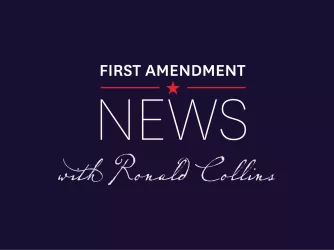Table of Contents
U. of Oregon Students Demonstrate Lack of Understanding of First Amendment Law

On Tuesday, a pro-life activist displaying a graphic poster depicting an aborted fetus on the University of Oregon (UO) campus attempted to give counter-protesters a lesson in First Amendment law, but video footage of the incident suggests few at the scene understood.
One campus police officer requested that the activist put the poster away, explaining that UO has “additional rules other than just freedom of speech,” such as a prohibition on “offensive or demeaning” expression. It isn’t the first time FIRE has seen someone in a position of authority at a public university, legally and morally bound by the First Amendment, suggest that the constitution can be trumped by the university’s conduct code—an administrator at Cameron University explicitly argued just that last May.
But the Supreme Court has repeatedly held that freedom of expression applies just as forcefully on public college campuses as anywhere else. This is simply incompatible with the idea that universities can diminish speakers’ rights simply by enacting a new conduct code provision. And, as the president and vice president of UO’s chapter of Young Americans for Liberty pointed out in an op-ed for the student newspaper the Daily Emerald, this viewpoint-based censorship is inconsistent with UO’s Free Speech Policy, which states that the university “supports free speech with vigor.”
In response to demands that he not display the purportedly “offensive” poster, the activist, unidentified in coverage by the Emerald, aptly summed up a central First Amendment principle. “The very reason it’s protected is because it’s controversial. … There would be no need to protect free speech if everybody agreed with it.” Thankfully, a campus sergeant eventually corrected his colleague’s misunderstanding, explaining to the first officer and the crowd that their job was only to prevent physical altercations, not to make a judgment on the content of the poster.
This, however, did not dissuade students from attempting to silence the activist through other strategies. One student, for example, grabbed the poster and stepped on it, folding it over and causing damage to the activist’s property. As we’ve explained on The Torch before, vandalism is not only illegal but also an act of censorship—an ineffective strategy if one’s goal is to actually persuade another.
The student censor attempted to defend her actions by stating that she “considered the sign obscene.” Another student, too, called the poster “obscene” and confidently yet inaccurately declared that the poster was “not part of [the activist’s] First Amendment rights.” FIRE often sees wrongful attempts to silence speech by labeling it “obscene.” But even though “obscenity” is a category of speech that is unprotected by the First Amendment, it has a very specific legal definition that is clearly not applicable to a picture of an aborted fetus. Just to start, “obscenity” must appeal to the prurient (i.e., sexual) interest. I do not think more analysis is warranted on this point.
More broadly speaking, the students who argued that the display of graphic photos are not constitutionally protected should note the Supreme Court’s statement in Papish v. Board of Curators of the University of Missouri (1973) that “the mere dissemination of ideas—no matter how offensive to good taste—on a state university campus may not be shut off in the name alone of ‘conventions of decency.’” In other words, since the poster does not constitute obscenity, or a threat, or incitement to imminent lawless action, or any other narrowly-defined unprotected type of speech, it is indeed part of the activist’s First Amendment rights.
The UO students’ (and one officer’s) gross underestimation of the breadth of what the First Amendment protects is disappointing. It is particularly disheartening to see attempts at censorship paired with vandalism. FIRE hopes that these students learn to communicate their viewpoints on abortion or other issues by participating openly in the “marketplace of ideas,” not by keeping certain viewpoints from being heard.
Recent Articles
FIRE’s award-winning Newsdesk covers the free speech news you need to stay informed.

No president gets to decide who deserves a lawyer

Free speech in an age of fear: The new system loyalty oaths – First Amendment News 464

AI is new — the laws that govern it don’t have to be
